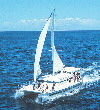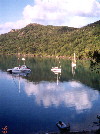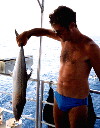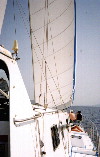
|
$359 per person
including all meals, but not
drinks, dives and government charges. Better prices are sometimes
available outside the peak times or on standby, so it pays to check the
prices. Prices do vary from season to season.
Dive prices are currently around $160 for 6 dives for certified
divers, and around $90 for two training dives or $150 for four dives for
beginners.
Government charges are a $5 per day Environmental
Management Charge (Reef Tax) levied on all visitors to the Great Barrier
Reef Marine Park. This $15 charge is collected on board. They are
not included in the quoted fees.
Prices include a courtesy coach from the Kelly Dive shop and return to
your accommodation. All meals are included, as is afternoon tea, and
snacks. You can buy candy and canned soft drinks on board, or bring
your own.
Since Pacific Star has no bar on board you bring your own alcohol,
but not in glass bottles (for safety). We grabbed some essential
supplies. A case of beer, two boxes of halfway decent wine, a six pack
of cider, the remains of a box of Lambrusco. It did look a little
excessive, since you can't dive after drinking, but there were three
evenings for partying, and sufficient refrigeration space.
We each packed a small, soft sided bag, making sure we had swimming
costume, towel, sunglasses, a hat that wouldn't blow overboard, and lots
of sunblock. You go barefoot on board, and dressing up for dinner isn't
expected, so shorts and a few shirts are enough clothes.
|
























